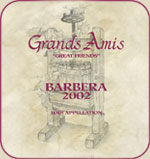 |
|
Wine Details
Price:
$17.99 per bottle
Description:
The 2002 Barbera is a vibrant wine. The color is bright red with lavender hues and with moderate depth. The bouquet of the wine is classically varietal focusing on dried rose petals, intense plums, and raspberry/sour cherry fruit. There is a complimenting cream caramel flavor from the oak. In the mouth, the flavors mimic the aroma, and the finish is fleeting and lively, again, very typical for this Italian varietal. This wine is ideal with rich tomato based food.
The grapes were grown in a vineyard on the northeast side of Lodi in deep rich Lodi loam soil. The vines were only lightly irrigated, and the yields were minimal to ensure that the flavors and tannins were concentrated in the fruit. Once harvested, the grapes were fermented, brought through extended maceration, pressed, and barrel aged for 14 months in French Seguin Moreau and Tonnellerie Saury barrels (66%) and Americal Radoux barrels (33 %). The final blend consists of 97% barbera, 2% carignange , and small amounts of zinfandel, petite sirah, and syrah
|
|
|